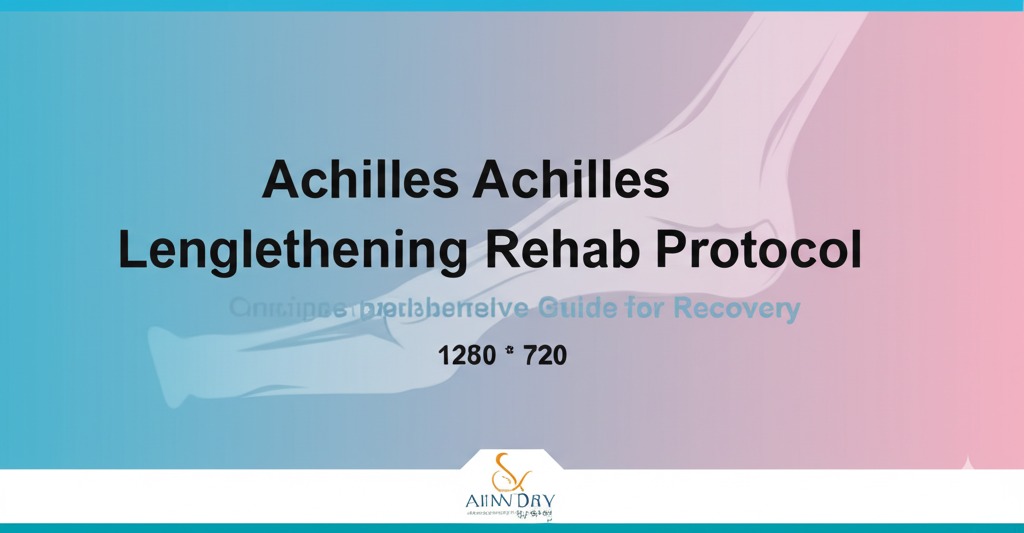Recovering from Achilles lengthening surgery can be a challenging process, but with the right rehabilitation protocol, you can regain mobility and strength. Whether you’ve undergone the procedure to address Achilles tendon issues or have other related concerns, following a structured rehab plan is essential for a full recovery. In this article, we’ll dive into the Achilles lengthening rehab protocol, offering a step-by-step guide to help you navigate through the recovery process.
Understanding Achilles Lengthening Surgery
Achilles tendon lengthening is a surgical procedure designed to address conditions where the tendon is too short or tight, such as in cases of contractures, equinus deformity, or other tendon-related issues. The procedure involves making precise cuts in the tendon to allow for greater flexibility and mobility.
While the surgery can significantly improve the range of motion, it’s essential to follow a well-structured rehab protocol to ensure proper healing and avoid complications.
The Importance of a Rehab Protocol Post-Surgery
After Achilles lengthening surgery, your body needs time to heal, and the tendon needs to adjust to the increased length. A rehab protocol is crucial for:
- Regaining mobility: The tendon needs to adapt to its new length to ensure you can walk, run, and perform daily activities.
- Strengthening muscles: The muscles surrounding the Achilles tendon may weaken during the healing process, so exercises are needed to rebuild strength.
- Preventing scar tissue: Scar tissue formation can limit the effectiveness of the surgery if not managed properly.
By following a dedicated rehab plan, you can reduce the risk of re-injury and ensure a smoother recovery process.
Key Phases of the Achilles Lengthening Rehab Protocol
Recovery from Achilles lengthening surgery typically follows a progressive rehabilitation protocol with specific phases. Here’s a breakdown of what each phase involves:
Phase 1: Immediate Post-Op Care (Weeks 1-2)
During the first two weeks after surgery, the focus is on managing pain and swelling, as well as preventing complications.
- Rest and elevation: Keep your leg elevated to reduce swelling.
- Ice therapy: Apply ice packs for 15-20 minutes every few hours to manage pain and inflammation.
- Protected weight-bearing: You’ll likely need to use crutches or a walking boot to avoid putting pressure on the tendon.
During this phase, you won’t perform any active rehabilitation exercises, as the tendon and surrounding tissues are healing from surgery.
Phase 2: Early Mobilization (Weeks 3-6)
Once the initial healing process has begun, your rehabilitation protocol will focus on gentle mobilization and restoring basic movement.
- Gradual weight-bearing: As directed by your surgeon or physical therapist, you’ll begin to put partial weight on your foot. The goal is to gently ease into walking without straining the tendon.
- Range-of-motion exercises: These exercises focus on gentle stretching of the Achilles tendon to restore flexibility. Start with passive stretching, progressing to active stretches as you gain mobility.
- Foot and ankle mobility: Ankle circles and gentle flexing and pointing of the toes help improve joint movement.
At this stage, the emphasis is on maintaining a balance between rest and movement to avoid overstretching the tendon while encouraging early healing.
Phase 3: Strengthening and Functional Training (Weeks 7-12)
As the tendon heals, it’s important to begin rebuilding strength and functionality in the affected leg.
- Strengthening exercises: Focus on calf raises, toe taps, and resistance band exercises. These movements strengthen the muscles that support the Achilles tendon.
- Stretching: Continue gentle stretching, focusing on improving flexibility and maintaining the newly gained length of the tendon.
- Balance exercises: Incorporate balance training using stability balls, balance boards, or single-leg standing to enhance proprioception and stability.
During this phase, your rehab plan will shift toward functional movements that allow you to move more naturally.
Phase 4: Return to Activity (Months 3-6)
The final stage of rehabilitation involves returning to more demanding activities while ensuring the Achilles tendon is fully functional and strong.
- Progressive loading: Gradually increase the intensity and duration of exercises, including activities like walking, jogging, and low-impact sports. Avoid high-impact exercises or activities that place excessive strain on the Achilles tendon during the early part of this phase.
- Plyometric exercises: Incorporate jumping and bounding exercises to help improve the tendon’s elasticity and strength.
- Sport-specific training: If you are an athlete, sport-specific drills can help prepare you for a safe return to your previous level of performance.
During this phase, it’s crucial to listen to your body and avoid pushing yourself too hard too soon.
Helpful Tips for a Successful Recovery
To make the most of your rehab protocol, consider these important tips:
- Consistency is key: Stick to your rehab schedule and don’t rush through exercises. Patience is crucial in the recovery process.
- Follow your healthcare provider’s advice: Always adhere to the guidance of your surgeon or physical therapist regarding weight-bearing, exercises, and timelines.
- Stay hydrated and maintain good nutrition: Proper hydration and nutrition are vital for tissue healing and overall recovery.
- Listen to your body: If you feel pain beyond the usual discomfort or notice swelling, it’s important to consult your healthcare provider.
Conclusion: A Steady Recovery for a Stronger Future
Rehabilitation after Achilles lengthening surgery is a gradual process, but with dedication and patience, you can restore the health and functionality of your Achilles tendon. By following the phases of the rehab protocol and staying consistent with your exercises, you’ll improve mobility, strengthen the tendon, and reduce the risk of further complications.
If you’re in the early stages of recovery or looking to optimize your rehab process, it’s always wise to consult with a physical therapist or healthcare provider to ensure your rehabilitation plan is tailored to your unique needs.

Kallie Snyder is an author at Stonegate Health Rehab, providing valuable insights, recovery guidance, and rehab resources to help individuals achieve better health and well-being.
